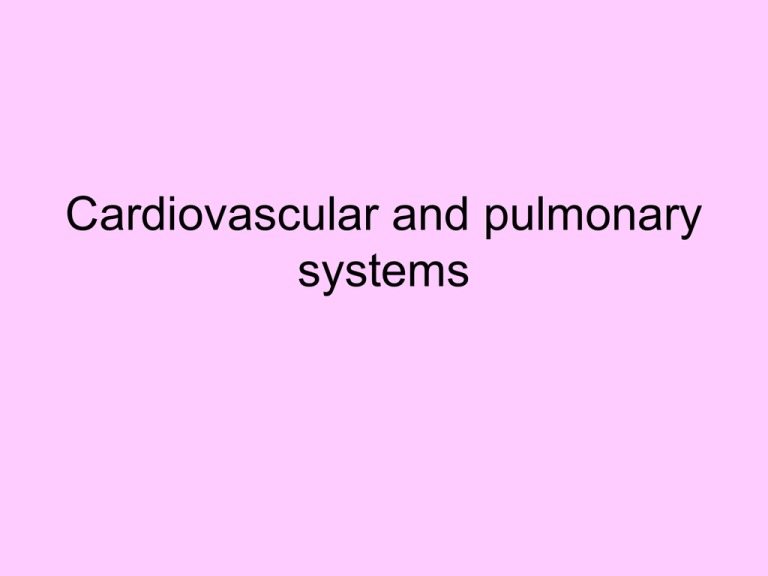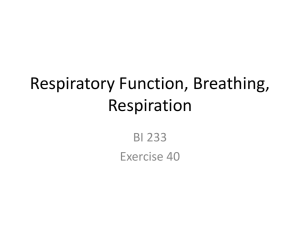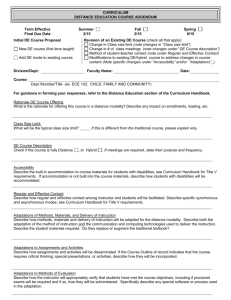CV and pulmonary
advertisement

Cardiovascular and pulmonary systems Mid Session Quiz -25% • • • • • • • • • Next week Will be on WebCT assessments From 9 am 25/8/08 5 pm 29/8/08 Multiple choice and matching Practice test (question types) up now, practice (content) on companion website for text. Covers all lecture, lab, text and reading materials from weeks 1-5 Time limit = ½ hour Grades will be released automatically Contact me if tech problems Today • Cardiovascular – System review – Acute adaptations to exercise – Chronic adaptations to exercise • Pulmonary – System review – Acute adaptations to exercise – Chronic adaptations to exercise Major Cardiovascular Functions • Delivers oxygen to active tissues • Aerates blood returned to the lungs • Transports heat, a byproduct of cellular metabolism, from the body’s core to the skin • Delivers fuel nutrients to active tissues • Transports hormones, the body’s chemical messengers CV system • Consists of; – Blood ~ 5L or 8% body mass • 55% plasma • 45% formed elements (99%RBC, 1%WBC) – Heart- pump – Arteries- High pressure transport – Capillaries- Exchange vessels – Veins- Low pressure transport Peripheral Vasculature • Arteries – Provides the highpressure tubing that conducts oxygenated blood to the tissues • Capillaries – Site of gas, nutrient, and waste exchange • Veins – Provides a large systemic blood reservoir and conducts deoxygenated blood back to the heart Blood Pressure • Systolic blood pressure – Highest arterial pressure measured after left ventricular contraction (systole) – e.g., 120 mm Hg • Diastolic blood pressure – Lowest arterial pressure measured during left ventricular relaxation (diastole) – e.g., 80 mm Hg Heart Rate Regulation • Cardiac muscle possesses intrinsic rhythmicity • Without external stimuli, the adult heart would beat at about 100 bpm Regulation of HR • Sympathetic influence – Catecholamine (NE/E) – Results in tachycardia • Parasympathetic influence – Acetylcholine – Results in bradycardia • Cortical influence – Anticipatory heart rate CV system during exercise Acute Adaptations Chronic adaptations Heart rate • At rest- 60-80 bpm – Trained athletes lower (28-40 bpm) • Pre exercise- anticipatory response – Sympathetic nervous system release N/E and ephedrine • Increases during exercise to steady state Cardiovascular Dynamics • Q = HR × SV (Fick Equation) – Q: cardiac output – HR: heart rate – SV: stroke volume Cardiac Output • At Rest – Q = 5 L p/Min Q = HR × SV • Trained RHR = 50 bpm, SV = 71 • Untrained RHR = 70 bpm, SV = 100 • During Exercise – Untrained- Q = 22 000 mL p/min, MHR = 195 » SV av 113 ml blood p/beat – Trained- Q= 35 000 ml p/min, MHR = 195 » SV av 179 ml blood p/beat Increases in Stroke Volume • Increases in response to exercise • Is ability to fill ventricles, particularly left ventricle • And more forceful contraction to pump blood out • Training adaptations – left ventricle hypertrophy – Increased blood volume – Reduced resistance to blood flow Training Adaptations: Heart • Eccentric hypertrophy – Slight thickening in left ventricle walls – Increases left ventricular cavity size Therefore increases stroke volume Cardiac output distribution Oxygen transport • When arterial blood is saturated with oxygen : • 1 litre blood carries 200 ml oxygen • During exercise – Q = 22L p /min • = 4.4L oxygen per minute • At rest – Q = 5L p/ min • = 1 L oxygen per minute • 250 ml required at rest • Remainder- oxygen reserves Stroke Volume and Cardiac Output • Exercise increases stroke volume during rest and exercise • Slight decrease heart rate • Increase in cardiac output comes from increased stroke volume Heart Rate • Elite athletes have a lower heart rate relative to training intensity than sedentary people Saltin, 1969 Endurance athletes Sedentary college BEFORE 55 day aerobic training program Sedentary college AFTER Total Blood Volume * Plasma volume -4 training sessions can increase plasma volume by 20% *Increased RBC - Number of RBC increases, but due to increase in Plasma volume, concentration stays the same Blood Pressure • Aerobic exercise reduces systolic and diastolic BP at rest and during exercise • Particularly systolic – Caused by decrease in catecholamines • Another reason for exercise to be prescribed for those with hypertension • Resistance training not recommended due to acute high BP it causes Oxygen Extraction • Training increases quantity of O2 that can be extracted during exercise Chronic Adaptations to Exercise- Chapter 10 Cardiovascular adaptations to training are extremely important for improving endurance exercise performance, and preventing cardiovascular diseases. The more important of these adaptations are, Size of heart ventricular volumes total blood volume - plasma volume - red cell mass systolic and diastolic blood pressures maximal stroke volume maximal cardiac output extraction of oxygen Factors Affecting Chronic adaptations • Initial CV fitness • Training: – Frequency- 3 x p/week • Only slightly higher gains for 4 or 5 times p/week – Intensity • Most critical • Minimum is 130/ 140 bpm = (av) 50-55% Vo2 max/ 70% HR max • Higher = better – Time • Or duration- 30 min is minimum – Type • Specificity Pulmonary System Pulmonary Structure and Function • The ventilatory system – Supplies oxygen required in metabolism – Eliminates carbon dioxide produced in metabolism – Regulates hydrogen ion concentration [H+] to maintain acid-base balance • At rest – Air in Tracheahumidified and brought to body temperature – divides into 2 branches lungs – Lungs hold 4-6 litres of ambient air- huge surface area – 300 million alveoli – 250 ml oxygen in and 200 ml Carbon dioxide out each minute Breathing Inspiration • Ribs rise • Diaphragm contracts (flattens) Moves downward (10cm) • Thoracic volume • Air in lungs expands • Pressure to 5 mm Hg below atmospheric pressure • Difference between outside air and lungs = air is sucked in until pressure inside and out is the same Expiration • • • • • Ribs move back down Diaphragm relaxes (rises) Thoracic volume Pressure Difference between outside air and lungs = air is pushed out until pressure inside and out is the same Pulmonary system during exercise Lung Volumes • Static lung volume tests – Evaluate the dimensional component for air movement within the pulmonary tract, and impose no time limitation on the subject • Dynamic lung volume tests – Evaluate the power component of pulmonary performance during different phases of the ventilatory excursion Spirometry • Static and Dynamic lung volumes are measured using a spirometer Static Lung Volumes Page 146 of text Dynamic lung volumes • Depend on Volume of air moved and the • Speed of air movement FEV/FVC ratio MVV FEV/FVC Ratio • Forced Expiratory Volume • Forced Vital Capacity • Ratio tells us the speed at which air can be forced out of lungs • Normal = 85% FVC can be expired in 1 second. Maximal Voluntary Ventilation • Breath as hard and fast as you can for 15 seconds • Multiply by 4 • And you have Maximal Voluntary Ventilation • MVV– Males:140-180 Litres – Females: 80-120 Litres – Elite athletes up to 240 Litres Minute Ventilation At Rest • 12 breaths per minute • Tidal volume = 0.5L per breath • = 6 Litres of air breathed p/min During Exercise • 50 breaths p/ minute • Tidal Volume = 2 L per breath • = 100L p/min Alveolar Ventilation • Minute ventilation is just total amount of air • Alveolar ventilation refers to the portion of minute ventilation that mixes with the air in the alveolar chambers • Minute ventilation minus anatomical dead space (150-200 ml)- the air that is in the trachea, bronchi etc Alveolar Ventilation = Minute ventilation (TV x breathing rate) – dead space Gas exchange Gas Exchange in the Body • The exchange of gases between the lungs and blood, and their movement at the tissue level, takes place passively by diffusion Oxygen Transport in the Blood • Combined with hemoglobin — In loose combination with the iron-protein hemoglobin molecule in the red blood cell • Each Red Blood Cell contains 250 million hemoglobin molecules • Each one can bind 4 oxygen molecules CO2 Transport in Blood • In physical solution – (~7%) dissolved in the fluid portion of the blood • As carbamino compounds – (~20%) in loose combination with amino acid molecules of blood proteins • As bicarbonate – (~73%) combines with water to form carbonic acid Regulation of Pulmonary Ventilation Regulation at rest: Plasma Pco2 and H+ Concentration • The partial pressure of CO2 provides the most potent respiratory stimulus at rest • [H+] in the cerebrospinal fluid bathing the central chemoreceptors provides a secondary stimulus driving inspiration Ventilatory Regulation During Exercise • Chemical control – Po2 – Pco2 – [H+] • Nonchemical control • Neurogenic factors – Cortical influence – Peripheral influence Ventilation in steady rate exercise • Of oxygen ( V E/ V O2) – Quantity of air breathed per amount of oxygen consumed – Remains relatively constant during steadyrate exercise- 25 L air breathed per 1L o2 consumed at 55% Vo2 max • Of carbon dioxide ( V E/ V CO2) – Remains relatively constant during steadyrate exercise Ventilatory Threshold • The point at which pulmonary ventilation increases disproportionately with oxygen uptake during graded exercise • The excess ventilation relates to the increased CO2 production associated with buffering of lactic acid Pulmonary adaptations to Exercise Adaptations to Maximal exercise • Minute ventilation increases • Increased oxygen uptake Submaximal Exercise • Ventilatory muscles stronger • Ventilatory equivalent for oxygen ( V E/ V O2) reduces indicates breathing efficiency – This leads to • Reduced fatigue in ventilatory muscles • O2 that would have been used by those muscles can be used by skeletal muscle. Pulmonary Adaptations • Increased tidal volume • Decreased breathing frequency • Increased time between breaths (Increased time for oxygen to get into bloodstream) • Therefore less oxygen in exhaled air Summary • Need to know – Cardiac and pulmonary Structure and Function • • • • Veins/arteries/cappilaries Flow of blood through the heart Alveoli bronchii etc Flow of inspired air and pulmonary exchange – Acute adaptations to exercise – Chronic adaptations to exercise






